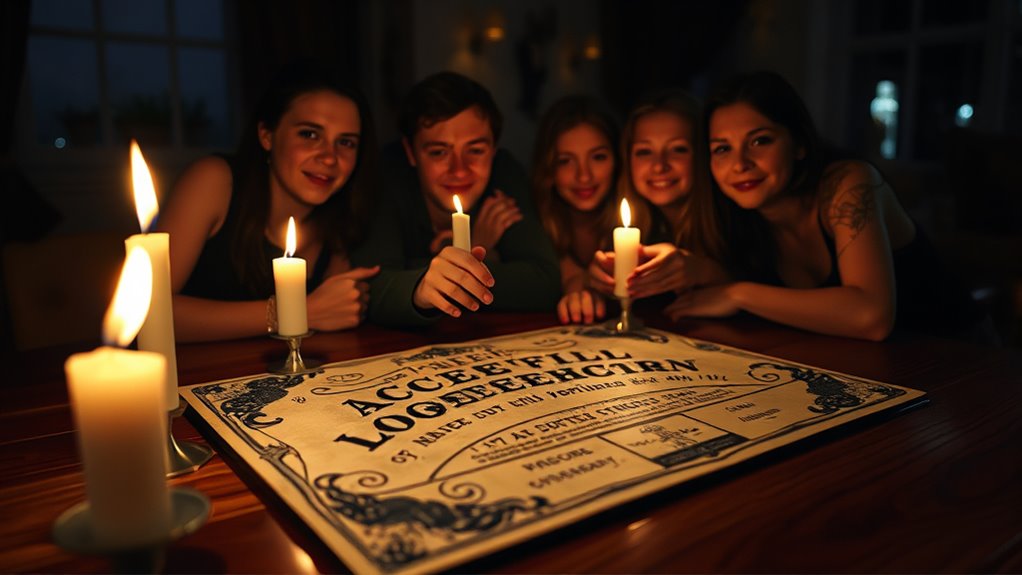The Ouija board myth mainly stems from historical roots and psychological effects rather than any real connection to spirits. It’s the ideomotor effect—your body making tiny, involuntary movements—that causes the planchette to glide across the board. Strong beliefs amplify this experience, leading to perceived paranormal communication. However, claims of facilitated communication often misinterpret these subconscious movements, creating ethical dilemmas. Want to understand more about these misconceptions and their implications? There’s plenty more to explore!
Key Takeaways
- The ideomotor effect causes unconscious muscle movements, leading to perceived communication on Ouija boards without any supernatural influence.
- Blindfolded participants produce incoherent messages, proving that the board does not facilitate genuine communication with spirits.
- Beliefs and expectations significantly influence Ouija board experiences, often amplifying the ideomotor effect rather than any paranormal occurrence.
- Facilitated Communication lacks scientific validity, raising ethical concerns about misinterpretations and the emotional harm it can cause to individuals with disabilities.
- Historical popularity of Ouija boards does not validate their effectiveness, as myths stem from cultural beliefs rather than actual capabilities.
The Historical Roots of Ouija Boards

Although many view the Ouija board as a modern curiosity, its origins are steeped in the 19th-century spiritualism movement in America.
After the Civil War, many sought ways to communicate with deceased loved ones, leading to the rise of talking boards. The first commercial Ouija board, marketed by the Kennard Novelty Company in 1890, combined the French and German words for “yes.”
The rise of talking boards after the Civil War sparked a quest for communication with the deceased, leading to the first commercial Ouija board in 1890.
William Fuld, who took over the patent in 1892, claimed it was a tool for spiritual communication, greatly popularizing it. By the 1850s, the use of a planchette made interaction easier and enhanced its appeal.
Although interest peaked in the 1960s and 70s, you can trace the roots of Ouija board users back to 19th-century spirit boards.
Understanding the Ideomotor Effect
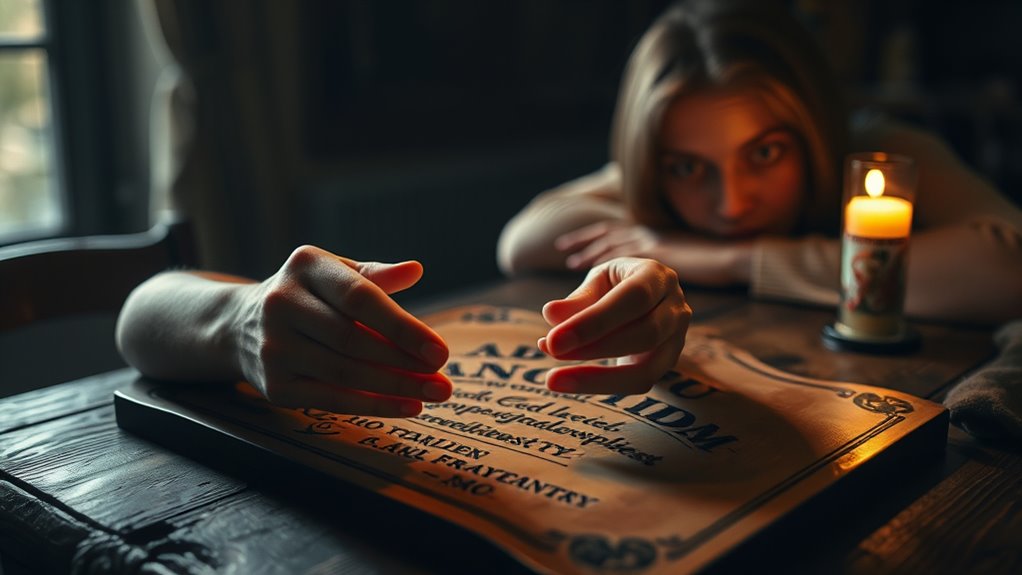
The fascination with Ouija boards often leads people to believe they’re communicating with spirits, but scientific explanations reveal a different story. The ideomotor effect explains how small, unconscious movements can create the illusion of movement on the board. You may not realize it, but your brain sends involuntary signals to your body, causing the planchette to glide across the surface.
- Muscle movements are often unconscious and unintentional.
- Blindfolded participants produce incoherent messages, proving no external influence.
- Historical experiments show how tiny movements amplify into larger effects.
- The ideomotor effect appears in other practices like dowsing, debunking supernatural claims.
Understanding the ideomotor effect clarifies that the interactions with Ouija boards stem from your own subconscious, not from spirits.
How Ouija Boards Operate Mechanically

Ouija boards rely on a simple mechanical design that captivates users while facilitating their interactions. At the heart of this design is the planchette, which you place your hands on to move. The movements you perceive are largely due to the ideomotor effect, where your subconscious drives small, involuntary motions. It’s fascinating how the board’s layout, featuring letters and numbers, enhances your experience, making you feel like you’re communicating meaningfully.
| Component | Function |
|---|---|
| Planchette | Moves to spell out messages |
| Letters/Numbers | Provides context for responses |
| Yes/No Options | Guides simple decisions |
In essence, your subconscious is what really makes you move the planchette, creating the illusion of external communication.
The Psychological Influence of Belief
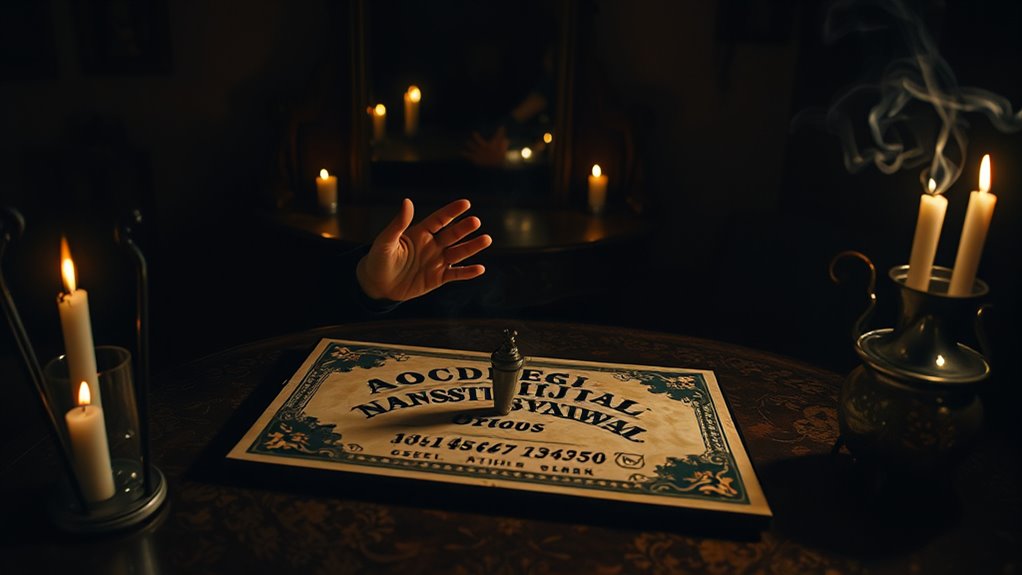
When you sit down with a Ouija board, your beliefs can strongly shape the experience. The power of belief can amplify the entire session, leading to feelings of excitement and involvement.
Here are some key points to reflect upon:
- Belief enhances user engagement and emotional response.
- The ideomotor effect shows how expectations guide the planchette’s movement.
- Participants with strong belief often report more paranormal experiences.
- Psychological consistency reinforces belief by aligning thoughts with actions.
Your belief not only influences your perception but also your experience with the board. The more you invest in the idea of the Ouija board’s power, the more vividly you might perceive the outcomes, highlighting just how significant belief is in shaping your reality.
Facilitated Communication: A Deceptive Technique
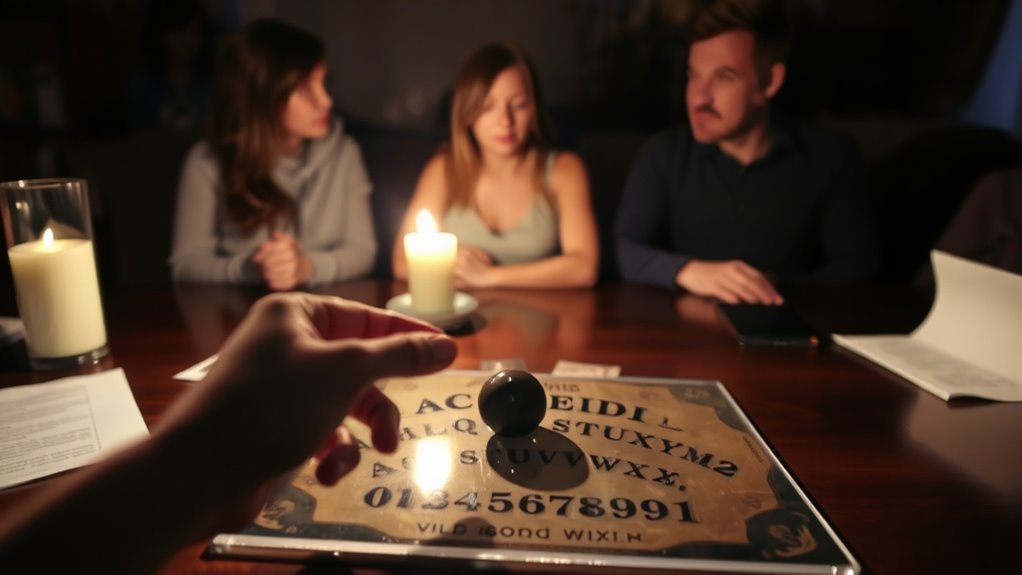
Facilitated Communication (FC) might seem like a breakthrough for those unable to communicate, but it often leads to serious misinterpretations of movements.
You need to recognize the ethical concerns and risks associated with FC, especially since scientific evidence reveals it lacks validity.
Understanding these facts can help you see why belief in such techniques can be misleading and harmful.
Misinterpretation of Movements
Although many believe facilitated communication (FC) offers a genuine way for disabled or autistic individuals to express themselves, it often relies on misinterpretations of involuntary movements.
Research shows that these movements are frequently driven by caregivers, not the individuals. This misinterpretation can lead to severe consequences, including false claims in sensitive situations, like consent in abuse cases.
Consider these points regarding FC’s deceptive nature:
- The ideomotor effect can influence movement subconsciously.
- Caregivers often misinterpret movements as meaningful.
- The persistence of FC under different names continues to cause harm.
- Experiences mirror the “Ouija board stuff” phenomenon.
Understanding the misinterpretation of movements is essential for recognizing the limitations of FC.
Ethical Concerns and Risks
While many view facilitated communication (FC) as a breakthrough for individuals with disabilities, it raises significant ethical concerns and risks.
This technique often leads people to misinterpret subtle finger movements that caregivers may unconsciously influence, rather than being genuine expressions of the individuals themselves. Such manipulation can result in severe consequences, including false claims, as seen in a notable case involving a sex abuse allegation.
The reliance on FC undermines autonomy and informed consent, as caregivers may misattribute meaning and control the narrative. Ultimately, this deceptive approach can cause lasting psychological harm, moving individuals away from true communication and understanding, reinforcing the need for responsible practices that respect the dignity and rights of people with disabilities.
Scientific Evidence Against FC
Many people believe that facilitated communication (FC) offers a genuine way for individuals with disabilities to express themselves, but scientific evidence strongly contradicts this notion.
Research shows that the slight finger movements attributed to FC are primarily driven by the ideomotor effect, much like how a planchette moves during a Ouija board session.
Key findings include:
- Caregivers often misinterpret these movements, creating unintentional messages.
- Blindfolded users produce incoherent or nonsensical outputs, debunking FC’s validity.
- A notorious case led to false allegations of abuse, highlighting the technique’s dangers.
- Despite discrediting, FC persists under names like the “rapid prompting method,” risking emotional harm to participants and their families.
The evidence is clear: FC is more illusion than communication.
The Dangers of Misinterpreting Subconscious Movements
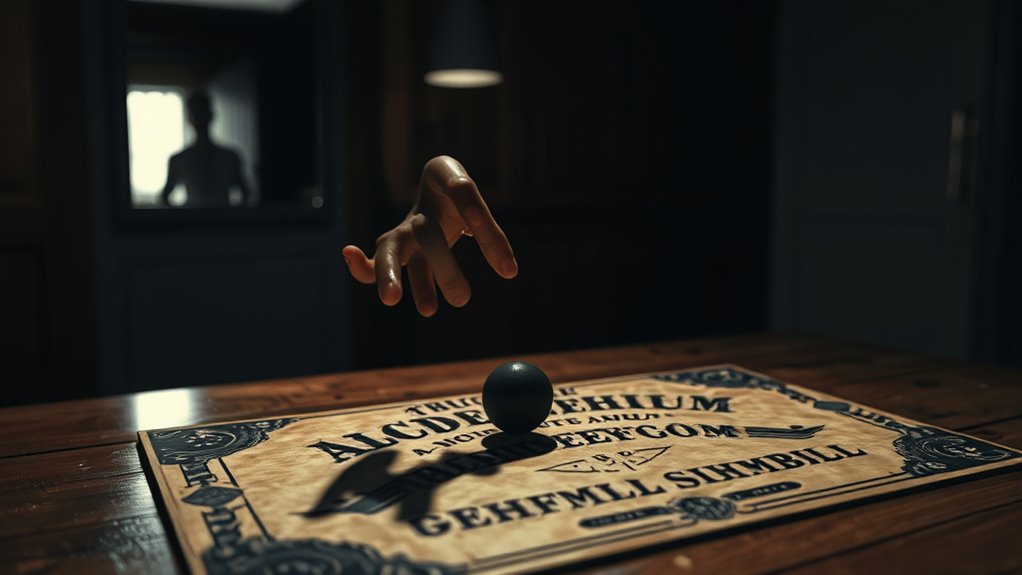
When you use a Ouija board, you mightn’t realize that the movements you perceive can stem from your subconscious rather than any supernatural force.
This misunderstanding can lead to misleading interpretations that not only distort your experience but also impact your psychological well-being.
Believing in these movements can heighten anxiety and fear, making it essential to critically assess what’s really happening during these sessions.
Misleading Interpretations of Movement
Although it may seem like a thrilling way to connect with the supernatural, the movements of the planchette on a Ouija board often stem from something much more human: the ideomotor effect.
When you and others expect communication from spirits, you might unconsciously move your hands, leading to misleading interpretations of movement. This misinterpretation can have real consequences:
- It may result in false accusations in legal contexts.
- Blindfolded users produce nonsensical messages, proving no external influence.
- Emotional harm can arise from believing in fabricated messages.
- Misattributing movements in facilitated communication can mislead caregivers.
Understanding that these movements are driven by human agency rather than supernatural forces is essential for a clearer perspective on the Ouija board experience. Additionally, recognizing the importance of cybersecurity measures can help protect individuals from potential psychological manipulation in various contexts.
Psychological Impact of Belief
Believing in the power of the Ouija board can lead to significant psychological effects, as users often misinterpret subconscious movements as messages from the beyond. This is largely due to the ideomotor effect, where your expectations and emotions trigger involuntary muscle movements.
When you engage in a Ouija session, the psychological impact of belief heightens your experience, making it easier to perceive genuine communication. Unfortunately, this can foster false beliefs, resulting in emotional harm.
Misunderstanding the source of these movements can have serious consequences, especially in sensitive situations like facilitated communication with disabled individuals. The risk of false accusations or undue influence in personal relationships illustrates just how dangerous these misinterpretations can be.
Debunking Common Myths Surrounding Ouija Boards

Despite the allure of Ouija boards as mystical tools for contacting spirits, many myths surrounding them can be easily debunked. The movements you see during a session are primarily due to the ideomotor effect, where your unconscious, involuntary movements guide the planchette.
Here are some common myths:
- Ouija boards are effective for spirit communication.
- Messages become coherent when participants are blindfolded.
- Historical popularity equates to supernatural validity.
- Facilitated Communication proves genuine communication with the disabled.
Ultimately, the appeal of Ouija boards lies in cultural beliefs and the human desire for connection, not in any actual supernatural capabilities.
Understanding these myths helps clarify that what you experience is more psychological than paranormal.
The Role of Collective Experience in Ouija Sessions

When you gather with others for a Ouija session, the collective experience greatly influences how you engage with the board. In group settings, curiosity and belief amplify the ideomotor effect, making it easier for the planchette to move. You may feel a heightened sense of agency, as shared emotional investment leads to a stronger connection with the board. Participants often underestimate their contributions, believing movements come from external forces. Here’s a quick look at how collective dynamics play a role:
| Aspect | Individual | Group |
|---|---|---|
| Predictive Ability | Limited | Enhanced |
| Emotional Investment | Personal | Shared |
| Sense of Control | Higher | Lower |
| Ideomotor Effect | Minimal | Amplified |
Frequently Asked Questions
Is Ouija Board Based on a True Story?
Imagine sitting in a dimly lit room, the air thick with anticipation. You might wonder if the Ouija board is based on a true story.
While its roots trace back to the 19th-century Spiritualism movement, it’s more folklore than fact. The board’s allure comes from cultural tales, but scientific evidence points to the ideomotor effect, showing that users’ subconscious drives the planchette, not spirits.
Why Were Ouija Boards Banned?
Ouija boards faced bans due to concerns over their influence on beliefs and mental well-being.
Many schools and religious institutions worry that using them promotes superstition or even encourages communication with spirits.
Incidents of emotional distress linked to Ouija sessions have raised alarms, prompting local authorities to restrict their use in community events.
As a result, you might find these boards banned in certain settings, reflecting society’s ongoing struggle with spiritual practices.
Why Did the Ghost Want People to Stop Using the Ouija Board?
You might wonder why a ghost would want people to stop using a Ouija board. Many tales suggest that spirits aim to protect the living from dangerous interactions with the supernatural.
However, these stories often stem from cultural myths and horror narratives rather than any real evidence. What you’re really seeing is a reflection of human fears about the unknown, rather than any genuine communication or warning from the deceased.
Does Ouija Board Work?
Like a mirage in the desert, the Ouija board seems to promise communication with the beyond, but does it really work?
When you place your fingers on the planchette, it might feel like it’s moving on its own, but that’s likely just your subconscious at play.
Studies show you’re more influenced by your thoughts and emotions than any spirit, making the board a fascinating psychological tool rather than a genuine link to another dimension.
Conclusion
To sum up, while many believe Ouija boards can connect them to the spirit world, the truth lies in psychology and mechanics. Did you know that about 70% of participants in Ouija sessions report feeling a presence, even when the movements are purely subconscious? This statistic highlights how powerful belief can be, shaping perceptions and experiences. By understanding the real factors at play, you can approach Ouija boards with a critical mindset, debunking the myth once and for all.
